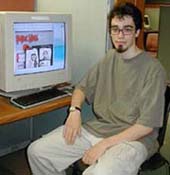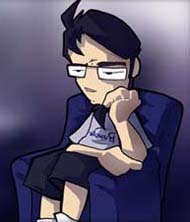| Comics Finding
Niche Audiences on the Net

|
| Matt Boyd with his strip, on the University of Maryland campus (Photo by Maha Ezzeddine)
|
By Maha Ezzeddine
Maryland
Newsline
Friday, May 3, 2002
Not everyone gets to have an alter ego. But Matthew Boyd, a junior journalism major at the University of Maryland, has one that attracts more than 70,000 readers a month--in an online
comic strip.
Boyd and Ian McConville, a sophomore computer art major at Bowling Green
State University in Ohio, are the creators of Mac Hall, the cyber intersection of two dorm rooms, two sets of roommates
and two senses of humor.

|
| Boyd's Web alias, "Matt." (Courtesy
of Matt Boyd)
|
They hardly know each other, but twice a week Boyd and McConville create a new episode together, in which their aliases meet to gripe over English papers, grind through midnight
KMart shifts, hang out with roommates and hover over computer screens.
Boyd writes the scripts, inspired mostly by the antics of his roommates. More than 300 miles away, McConville brings them to life in a blending of pencil sketches and computer graphics,
using his friends and roommates as visual inspiration. Although the characters have the names and faces of real people, the comic-strip versions have developed personalities of their own,
said Boyd, 20.
"Our characters aren't all that like us anymore," he said. But no one complains; the only grumbles are from friends who don't get put into the strip, he said.
McConville and Boyd are among a growing crowd of amateur and professional cartoonists who are testing out
new art forms and audiences on the Internet.
"Things are moving fast" online, said Scott McCloud, a cartoonist and artist from California who is best known for his book "Understanding Comics."
Some of the biggest advantages an
online comic creator has are the immediacy of the messages and
the online responses
from readers, he said.
"A cartoon can upload at 10:30, and people can be reading it at 10:31," McCloud said. "That's very exciting."
Web Vs. Newsprint
Since the mid 1990s when online comics became popular, thousands of
cartoonists have launched
their comics on Web sites, McCloud said. All the creators need to
get started is a site and an idea, he said.
That's different from breaking into the newspaper comic industry, where the most popular cartoonists compete for a few spaces, McCloud said. Those who don't want to cater to the
selectivity, space limitations and broad humor requirements of print comics often turn to the
Web, he said.
"If you can do this," said Boyd, pointing to a comic awash in colors and special effects on his computer screen,
"why confine yourself to a couple of spaces in a black and white box?"
The Internet is also a haven for cartoonists escaping the censorship of
print comics. Jerry Holkins, one of the creators of Penny Arcade, said his
Web comic would not be
popular in print because it appeals to a small audience of online gaming fans.
Boyd said a
lot of the Mac Hall themes and language wouldn't be suited for
newsprint, either. The strip appeals mostly to
high school and college students, he said.
The membership requirements of the National Cartoonists Society, a national organization that "celebrates, promotes and advances the highly specialized art of cartooning," would exclude
many online cartoonists. According to NCS membership chairman Rick Stromoski, members must
earn an income from their cartooning and have published clips of "high professional quality"
work.
Only a handful of online cartoonists are making a living off their work, said Pete Abrams, creator of one of the older, serial Web comics,
Sluggy Freelance. Abrams, who lives in New
Jersey and has been creating his comic for four-and-a-half years, said he is one of the few who has managed to get a steady paycheck from his online strip, which he said gets between 7 million and 8 million page views a month.
Abrams said he gets most of his income from merchandise sales, advertising
on the site and sales of his online comic collections in book form.
"There isn't a clear business model yet," McCloud said. "That doesn't mean there's not going to be."
Creating a Business Model
A business model is in progress at Moderntales.com, a cooperative of Web cartoonists.
Viewers must pay a $2.95 monthly fee to see
the strips. The concept was developed by Joey Manley, a Web
cartoonist who persuaded about 20 other cartoonists to join.
"It sounded like an intriguing idea, but I was aware of the stigma against paying for online content," said Indigo Kelleigh, creator of
The Circle Weave, one of the comics featured on
the site.
Shaenon Garrity, who produces Narbonic, also on Moderntales.com, was
skeptical
of the arrangement at first. But she said she soon discovered that the site wasn't run by "some mad would-be dotcom millionaire" and had the
"mysterious power to attract fantastic cartoonists."
Finally, online cartooning was developing a reliable system of compensation for artists, she said.
Now, Garrity, who is based in San Francisco and draws her comics at night, said she is hoping to get more than just a Christmas bonus from selling
Narbonic merchandise.
"You don't enter this business to get rich," she said. "However, if Modern Tales continues to succeed, it may allow more people to make a living from Web comics."
McCloud said all the business needs is a little time.
"There is room for innovation and trailblazing, but there aren't 30-year-old success stories with the Net yet," said Scott Kurtz, 29, of Euless, Texas, who creates the comic
PVP online.
Kurtz quit his day job two years ago to draw the comic full time.
Someone will eventually do something that will make everyone sit up, Boyd said. "I don't think it will be me, but maybe someone who reads ours and makes their own," he said.
Meanwhile, Boyd and his partner sell enough T-shirts and mug and mouse pads with Ian and Matt in classic poses to generate enough cash to cover some of the costs of design materials. But
neither expect to profit from their work any time soon. Like many online cartoonists, they
say they're in it for the fun.
"We keep doing it, one step at a time," Boyd said. "We hardly think what's next, just keep stumbling forward."
Experimenting With the Form
A number of Web cartoonists, including Boyd, are experimenting with the long narrative--a series of comics that produce a serial "graphic novel," with chapters added periodically.
According to many cartoonists, long storylines walk a narrow line between creative, gripping plots and monotony.
Jim Zubkavich, from Calgary, Alberta, is experimenting with this approach in his Web comic The Makeshift
Miracle, which is "part
'Stand By Me,' part 'Sandman' and a little bit of a Hayao
Miyazaki movie all tossed together." Zubkavich said his comic, hosted on Moderntales.com, will go on for about 10 or 12 chapters, when he will finally wrap it up and come back with a completely different storyline "so people don't pigeon hole me."
The Circle Weave, created by Indigo Kelleigh, does not have as clear a future as Zubkavich's story. According to Kelleigh, his story line, inspired by classic epic myths, has been developing over the past 12 years. He's not quite sure where it's going.
"The story is really growing around the characters I keep putting into it," he said. "It's fun to watch, for me, because I don't always know what's coming next."
Boyd said he likes creating the long story lines, but they can easily become tedious with only one or two updates a week. "We're still experimenting with that," he said.
Although brains jump out of students' heads and weird dorm creatures prowl the halls at 3 a.m., Mac Hall, like many online comics, still has an element of reality, Boyd said.
"We try to get at something, so people can see the characters and say, 'Hey, I know someone like
that,' " he said. "We can just do a comic about me and my friends and the dumb things we
talk about. And people will read it."
Boyd said some of the ideas for Mac Hall were inspired by Penny Arcade, created in 1998 by
Holkins and Mike Krahulik. It was just a story about "two guys talking
about video games," Boyd said.
That's the charm of creating comics on the Web--no matter how niched the idea, it will have an audience, Boyd said.
He said he plans to stick with Mac Hall for a while, despite school deadlines and papers that sometimes stand in the way of getting the comics out on time. "It's just that people are expecting a comic the next day, so we do it," he said.
Copyright ©
2002 University of Maryland College of
Journalism
Top of Page | Home Page
|


